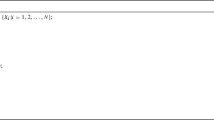Abstract
The firefly algorithm (FA) is a new and powerful algorithm for optimization. However, it has the disadvantages of high computational complexity and low convergence accuracy, especially when solving complex problems. In this paper, an accurate partially attracted firefly algorithm (PaFA) is proposed by adopting a partial attraction model and a fast attractiveness calculation strategy. The partial attraction model can preserve swarm diversity and make full use of individual information. The fast attractiveness calculation strategy ensures information sharing among the individuals and it also improves the convergence accuracy. The experimental results demonstrate the good performance of PaFA in terms of the solution accuracy compared with two state-of-the-art FA variants and two other bio-inspired algorithms.





Similar content being viewed by others
References
Yang X-S (2008) Nature-inspired metaheuristic algorithms. Luniver Press, New York
Yang X-S (2009) Firefly algorithms for multimodal optimization. In: International symposium on stochastic algorithms. Springer, Berlin, pp 169–178
Yang X-S, He X (2013) Firefly algorithm: recent advances and applications. Int J Swarm Intell 1(1):36–50
Yu S, Su S, Lu Q, Li H (2014) A novel wise step strategy for firefly algorithm. Int J Comput Math 91(12):2507–2513
Yu S, Zhu S, Ma Y, Mao D (2015) A variable step size firefly algorithm for numerical optimization. Appl Math Comput 263:214–220
Wang H, Zhou X, Sun H, Yu X, Zhao J, Zhang H, Cui L (2017) Firefly algorithm with adaptive control parameters. Soft Comput 21(17):5091–5102
Abdullah A, Deris S, Mohamad MS, Hashim SZM (2012) A new hybrid firefly algorithm for complex and nonlinear problem. In: DCAI. Springer, Berlin, pp 673–680
Hassanzadeh T, Meybodi MR (2012) A new hybrid algorithm based on firefly algorithm and cellular learning automata. In: 2012 20th Iranian conference on electrical engineering (ICEE). IEEE, pp 628–633
Wang H, Wang W, Sun H (2015) Firefly algorithm with generalised opposition-based learning. Int J Wirel Mobile Comput 9(4):370–376
Wang H, Wang W, Sun H, Rahnamayan S (2016) Firefly algorithm with random attraction. Int J Bioinspir Comput 8(1):33–41
Verma OP, Aggarwal D, Patodi T (2016) Opposition and dimensional based modified firefly algorithm. Expert Syst Appl 44:168–176
Zhang Y, Song X, Gong D (2017) A return-cost-based binary firefly algorithm for feature selection. Inf Sci 418:561–574
Eberchart RC, Kennedy J (1995) Particle swarm optimization. In: IEEE international conference on neural networks, vol 4. IEEE, Perth, pp 1942–1948
Yang X-S (2010) A new metaheuristic bat-inspired algorithm. In: Nature inspired cooperative strategies for optimization (NICSO 2010), pp 65–74
Liang J, Qu BY, Suganthan PN, Hernández-Díaz AG (2013) Problem definitions and evaluation criteria for the CEC, 2013 special session on real-parameter optimization. Technical Report 201212, Computational Intelligence Laboratory, Zhengzhou University, Zhengzhou, China and Nanyang Technological University, Singapore, pp 3–18
Wang H, Cui Z, Sun H, Rahnamayan S, Yang X-S (2017) Randomly attracted firefly algorithm with neighborhood search and dynamic parameter adjustment mechanism. Soft Comput 21(18):5325–5339
Shi Y, Eberhart R (1998) A modified particle swarm optimizer. In: The 1998 IEEE international conference on evolutionary computation proceedings, 1998. IEEE world congress on computational intelligence. IEEE, pp 69–73
Yang X-S, Hossein Gandomi A (2012) Bat algorithm: a novel approach for global engineering optimization. Eng Comput 29(5):464–483
Acknowledgements
The authors thank the Chinese National Natural Science Foundation (No. 61379059) and the Fundamental Research Funds for the Central Universities, South-Central University for Nationalities (No. CZY18012) for financial support for this work.
Author information
Authors and Affiliations
Corresponding author
Ethics declarations
Conflict of interest
The authors declare that there are no conflict of interests regarding the publication of this paper.
Informed consent
Informed consent was obtained from all authors included in the study. This manuscript does not contain any studies with human participants or animals performed by any of the authors.
Rights and permissions
About this article
Cite this article
Zhou, L., Ding, L., Ma, M. et al. An accurate partially attracted firefly algorithm. Computing 101, 477–493 (2019). https://doi.org/10.1007/s00607-018-0645-2
Received:
Accepted:
Published:
Issue Date:
DOI: https://doi.org/10.1007/s00607-018-0645-2




